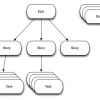 |
Estimating Business Value in the Shark Tank You can use analytical methods to assign business value to a user story, of course, but another way is simple estimation. Allan Kelly describes an estimation exercise that combines the Scrum tool of planning poker with a TV show format to add some fun. You end up with enlightening conversation and revealed requirements.
|
|
 |
Assessing the Business Value of Agile User Stories Allan Kelly says that ideally, companies should put a dollar amount on each planned business decision. But pinning down financial value can be hard, and besides, there are many other factors to consider, such as sustainability and customer service. He looks at various ways to assess the business value of user stories.
|
|
 |
Stories, Epics, and Tasks: Organizing Agile Requirements Some teams only work with stories, but it can be difficult for a team new to agile to write stories that are easy to understand and provide value every time. An alternative is to add epics and tasks. Understanding the differences between each level and knowing what size story to use for each situation will improve the accuracy of your sprint planning.
|
|
 |
Know Your Customers: They Can Help You Write Better User Stories Too many user stories begin, "As a user …" Who is your user? Or, more accurately, who are they? Improving your understanding of the types of customers who use your software lets you see multiple products where previously, there was only one—and identifying dedicated products will help you prioritize and accelerate delivery.
|
|
 |
Relieving Agile Tension: How to Write Small Stories That Still Have Value There are two practical goals for user stories: Each story should be beneficial to the business, and each story should represent a small piece of work. However, there is tension between these rules, and they often push in opposite directions. This article discusses how to keep stories small and tasks manageable, while ensuring they retain business value.
|
|
 |
The Three Amigos Strategy of Developing User Stories Developing software correctly is a detail-oriented business. George Dinwiddie writes on how using the Three Amigos strategy can help you develop great user stories. Remember, the goal is to have the work done just in time for planning and development. It should be complete enough to avoid stoppages to build more understanding, but not so far in advance that the details get stale.
|
|
 |
How Visualization Boards Can Benefit Your Team While many teams can use help structuring their conversations, some teams also need some way to know whether the structured conversations that have taken place have provided sufficient information. Kent McDonald explains how using visualization boards can help in these situations.
|
|
|
|
Identifying and Improving Bad User Stories A written user story is a very short narrative—a sentence or two—describing some small piece of functionality that has business value. User stories are intended to foster collaboration and communication, but writing these short narratives poorly can negate agile’s flexibility. Charles Suscheck and Andrew Fuqua explain some common failure patterns that will help you focus on the right role, value, and business functionality when writing stories.
|
|
|
|
Defining Requirement Types: Traditional vs. Use Cases vs. User Stories If you have recently transitioned to an agile team, you may have questions about the differences between user stories and use cases, especially how they differ from tradition requirements writing. In this article, Charles Suscheck defines each of these requirements types and uses a running example to illustrate how they differ in a real-world setting.
|
|
 |
Stop the Wishful Thinking: Software Estimation Reality Check Daryl Kulak tackles the most common beliefs in software development regarding estimating, and shows us ways and methods to help developers deal with the demands of businesspeople.
|
|
